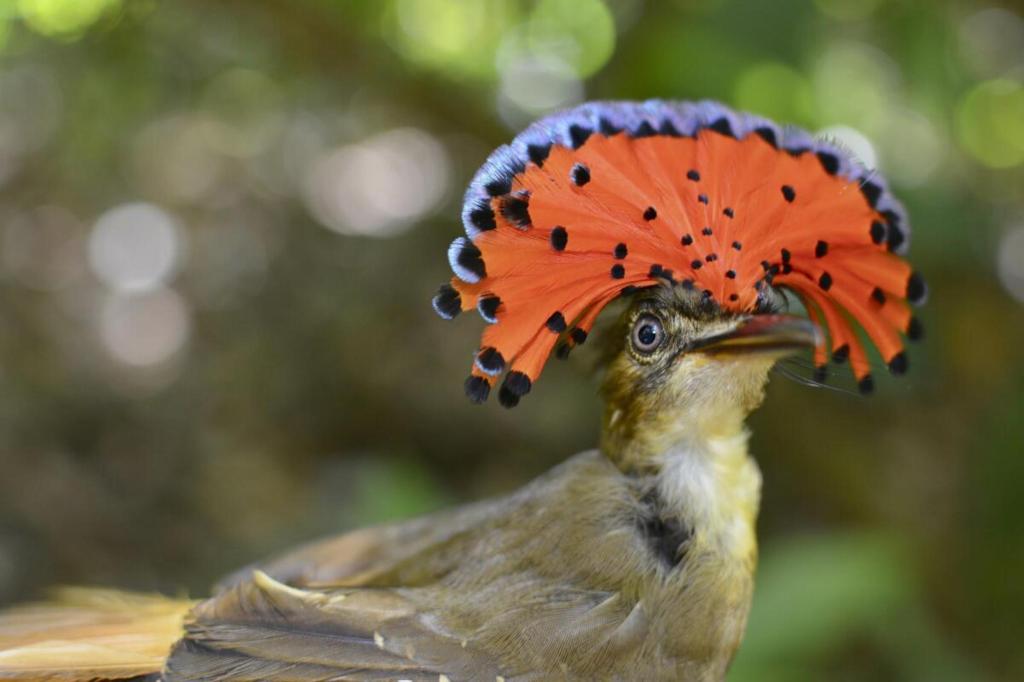News of the weird: Farms with natural landscape features provide sanctuary for some Costa Rica rainforest birds
Published 8:54 am Tuesday, September 5, 2023

- A royal flycatcher bird in Las Cruces Biological Station is photographed in Coto Brus, Costa Rica, in March 2018. Small farms with natural landscape features such as shade trees, hedgerows and tracts of intact forest provide a refuge for some tropical bird populations, according to an 18-year study in Costa Rica, published on Monday, Sept. 4, 2023, in the journal Proceedings of the National Academy of Sciences.
COTO BRUS, Costa Rica — Small farms with natural landscape features such as shade trees, hedgerows and tracts of intact forest provide a refuge for some tropical bird populations, according to an 18-year study in Costa Rica.
For almost two decades, ornithologist James Zook has been collecting detailed records on nearly 430 tropical bird species found on small farms, plantations and undisturbed forests in the country.
While birds thrive the most in undisturbed rainforests, Zook said some species usually found in forests can establish populations in “diversified farms” that partially mimic a natural forest environment.
“How you farm matters,” said Nicholas Hendershot, a Stanford University ecologist and co-author of the study published Monday, Sept. 4, in the journal Proceedings of the National Academy of Sciences.
“In these diversified farms, you see growth over the long term in bird species with specialized needs,” such as safe and shady nooks to build nests and a variety of food sources, Hendershot said.
That trend was “in stark contrast to what we saw in intensive agriculture,” or monocrop pineapple and banana plantations, he said.
The findings may seem intuitive, but Natalia Ocampo-Penuela, a University of California, Santa Cruz conservation ecologist not involved in the study, said it’s extremely rare to have detailed long-term data from tropical regions to show that varied farming landscapes can sustain some forest bird populations.
“With 18 years of data, you can show the species is persisting in that area, not simply passing by,” she said.
Three-quarters of the 305 species found in diversified farms showed stable or growing populations over the time of study. These include the collared aracari, a small toucan-like bird with a yellow chest and enormous beak, as well as several members of the manakin family — small brightly colored forest birds known for elaborate courtship dances.
“It’s a huge contribution to have documented that some birds aren’t just going there, but staying there and populations are growing,” said Ruth Bennett, an ecologist at the Smithsonian Migratory Bird Center, who was not involved in the research.
Still, such habitat sanctuaries don’t offset overall population losses from the conversion of primary forests to plantations, the authors stressed. “A pineapple plantation is like a ‘bird desert’ here,” said Zook.
Increasingly, scientists say conserving species will require paying attention to landscapes with a human footprint — not just untouched areas.
“Modern conservation has to happen not only inside the fences of protected areas but within agricultural areas and even urban areas, where there’s potential habitat for at least some species,” said the University of California’s Ocampo-Penuela.
Fish with a funny float gets a CT scan at the Denver Zoo
DENVER — A fancy-looking French angelfish that was found one day with a funny float has its buoyancy back after taking some time from its tropical trappings to get a CT scan at the Denver Zoo.
A zoo worker recently noticed the blue and yellow fish was swimming with a tilt, prompting a visit last week to the facility’s on-site hospital for an ultrasound and the CT scan.
The CT scan took place in a machine large enough to fit a 700-pound grizzly bear, so some special accommodations were required, zoo spokesperson Jake Kubie said. The approximately seven-inch fish was sedated, balanced upright on a sponge and had water poured over its gills to keep it alive as the scan took place.
The diagnosis: Too much gas. Enteritis, or inflamed intestines, had resulted in increased internal gas that was affecting the fish’s buoyancy, Kubie said.
“It was treated with antibiotics,” he said. “It’s doing much better and swimming normally.”
North Korea’s Kim Jong Un may meet with Putin in Russia this month, U.S. official says
WASHINGTON — A U.S. official said Monday, Sept. 4, that North Korean leader Kim Jong Un may travel to Russia soon to meet with President Vladimir Putin as the Kremlin tries to acquire military equipment for use in its war in Ukraine.
The official, who was not authorized to address the matter publicly and spoke to The Associated Press on condition of anonymity, said the U.S. expects Kim will make the trip within the month. The official said the U.S. isn’t sure exactly where or when the meeting would take place, but the Pacific port city of Vladivostok would be a likely possibility given its relative proximity to North Korea.
National Security Council spokesperson Adrienne Watson noted that Russian Defense Minister Sergei Shoigu traveled to Pyongyang recently and tried to persuade North Korea to sell artillery ammunition to Russia.
“We have information that Kim Jong Un expects these discussions to continue, to include leader-level diplomatic engagement in Russia,” Watson said.
She added that the U.S. is urging North Korea “to cease its arms negotiations with Russia and abide by the public commitments that Pyongyang has made to not provide or sell arms to Russia.”
Shoigu said that the two countries may hold joint war games.
Burning Man revelers begin exodus after flooding left tens of thousands stranded in Nevada desert
BLACK ROCK DESERT, Nev. — Muddy roads flooded by a summer storm that left tens of thousands of partygoers stranded for days at the Burning Man festival had dried up enough by Monday, Sept. 4, to allow them to begin their exodus from the northern Nevada desert.
Event organizers said they started to let traffic flow out of the main road around 2 p.m. local time — even as they continued urging attendees to delay their exit to help ease traffic Sept. 4. About two hours after the mass departure began, organizers estimated a wait time of about five hours.
The annual gathering, which launched on a San Francisco beach in 1986, attracts nearly 80,000 artists, musicians and activists for a mix of wilderness camping and avant-garde performances.
Organizers also asked attendees not to walk out of the Black Rock Desert about 110 miles north of Reno as others had done throughout the weekend, including DJ Diplo and comedian Chris Rock. They didn’t specify why.
The festival had been closed to vehicles after more than half and inch of rain fell Sept. 1, causing flooding and foot-deep mud.
The road closures came just before the first of two ceremonial fires signaling an end to the festival was scheduled to begin Sept. 2. The event traditionally culminates with the burning of a large wooden effigy shaped like a man and a wood temple structure during the final two nights, but the fires were postponed as authorities worked to reopen exit routes by the end of the Labor Day weekend.
“The Man” was torched Sept. 4 while the temple went up in flames Sept. 5.
“We are a little bit dirty and muddy, but spirits are high. The party still going,” said Scott London, a Southern California photographer, adding that the travel limitations offered “a view of Burning Man that a lot of us don’t get to see.”
Disruptions are part of the event’s recent history: Dust storms forced organizers to temporarily close entrances to the festival in 2018, and the event was twice canceled altogether during the pandemic.
At least one fatality has been reported, but organizers said the death of a man in his 40s wasn’t weather-related. The sheriff of nearby Pershing County said he was investigating but has not identified the man or a cause of death.






